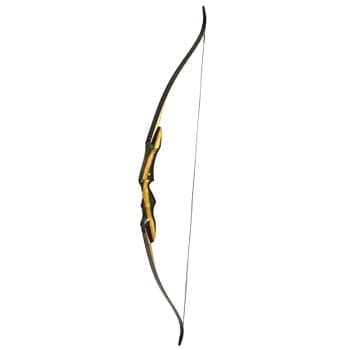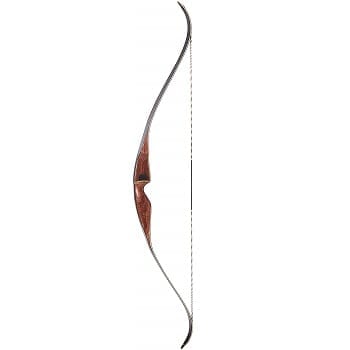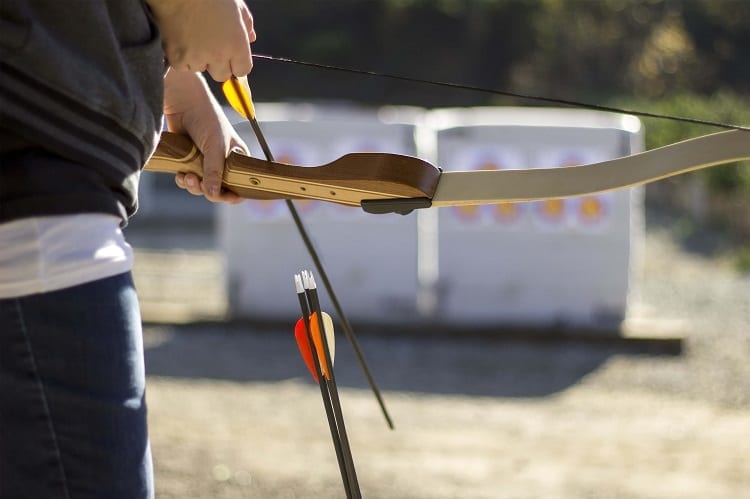When was the last time you truly hit your target?
You might be using the wrong type of bow if you’re not improving with discipline and hard work.
Determination will get you far, but the right equipment can give you another leg to stand on.
Recurve bows are one of the most common type of bows, because they work great for beginners and veteran bow users alike.
This list of recurve bows basically sums up everything that you need to know about the recurve structure, from our review of the top five on the market to our answers to frequently asked questions.
If you’re a newcomer or you’re switching over from another type of bow, you’ll leave here with a fundamental understanding of what makes a recurve bow tick, and how to spot the good bows from the bad.
Our Reviews Of The Best Recurve Bows
#1 Samick Sage Takedown Recurve Bow
Samick managed to craft the best beginner recurve bow like it was nothing.
This is a takedown bow, which means you can take the limbs off when you’re done (and you should) for storage.
This reduces the wear and tear on the limbs and the string as well, so you’re not damaging it while in storage.
What makes this the best recurve bow is the feeling when you pull the string back.
You’re pulling back on maple, metal and black fiberglass, which all blend seamlessly together to give it that flexibility and sturdiness that you’re after.
It’s difficult to hit both of those marks at the same time, but Samick somehow managed to do it with style.
Since this isn’t a compound bow, it isn’t adjustable, but they do offer a wide range of sizes. You can get from a 25 lb bow up to a 60 lb bow, with 5 lb interval sizes in the middle.
Sometimes you run into left-handed bows being slightly more expensive than right-handed (something about inventory cost or whatever), but Samick charges the same price either way, as it should.
It’s a ridiculously affordable recurve bow that doesn’t take much time to disassemble, and even less time to get used to.
The ergonomic grip features the perfect spot for your hand to rest and feel the tension of the bow as you pull the string back.
Hands-down, for cost, durability and simply giving a straight shot, Samick takes the cake.
Technical specifications
- Size: 62”
- Weight: 2.2 lbs
- Max Draw Length: 29”
- Draw Weight: 25 - 60 lbs
- Material: Fiberglass, maple wood, metal
#2 Spyder Takedown Recurve Bow

From the makers of the Samick Sage, the Spyder takedown improves upon that design in some areas, and falls short in others.
Look through the recurve bow reviews and you’ll constantly find comparisons between this and the Sage, but to us, they each offer differences that should be celebrated.
For one, there’s no fiberglass in this bow design, but there’s no metal either. It’s sourced from four different types of natural wood that’s all blended together to make this beast of a bow.
As the best recurve bow for hunting, you get to choose from 20 lbs of power up to 60, so you can get a bow for a beginner to scale their way up to the usual 40 lb minimum mark required for hunting in the United States.
There’s a bow size for every stage of development. Right-handed and left-handed models are the same price, and overall, the price matches the Samick, making this a really, really close second.
The takedown limbs work great, but they’re a bit complicated to remove. You’ll need the inclusive tools in order to get the job done, just be sure not to lose them.
When you’re picking your bow, you can also choose whether or not you want them to include a bow stringer in the package.
It bumps up the cost a tiny bit, but the increase is negligible when you consider what it costs to buy a stringer on your own.
Good draw weight, good draw length, and as close to original archery bows as you’re going to get.
Technical specifications
- Size: 62”
- Weight: 2.4 lbs
- Max Draw Length: 28”
- Draw Weight: 20 - 60 lbs
- Material: Four natural woods
#3 Courage SAS Hunting Takedown Bow

Courage sits on the list of the best recurve bow brands for a reason: they’re not messing around.
They don’t have an interest in providing anything that you can’t take down a target with, which is why the minimum draw weight on this is 50 lbs, with two more sizes available scaling up.
That’s more than enough to meet requirements in all fifty states: they want you to hunt.
While recurves can also be used in competitive archery, and the SAS bow is no exception, the woodsy feeling to it is going to be something that you’ll fall in love with while you’re in a tree stand, waiting for prey.
Primarily made of hardwood, the limbs are coated in fiberglass to promote elasticity and flexibility.
It’s not enough that it damages the aesthetics of the bow.
Speaking of aesthetics, the wooden handle look smooth and perfect, but it also feels that way once you slip your fingers around it.
The one downside is that it’s lacking grip, but the ergonomic design will contour to your hand very nicely. Just be sure that you actually have it steady before you pull back.
As far as taking down the recurve limbs, it’s pretty easy to do. You’ll need the assistance of a few tools, but it’s not going to give you a whole lot of resistance.
Last but not least, there’s a three-year warranty on this—that’s practically unheard of. The price range doesn’t go more than a few percentage points above the Samick, but
Courage is so confident in this bow’s capabilities that it’s willing to bet over a thousand days of hardcore use on it.
That’s confidence in your product; in the best takedown recurve bow that money can buy.
Technical specifications
- Size: 60”
- Weight: 1.4 lbs
- Max Draw Length: 29”
- Draw Weight: 50 - 60 lbs
- Material: Hardwood, fiberglass
#4 PSE 10 Snake Recurve Bow

PSE might have made the best recurve bow for target shooting, even if you’re used to a higher draw weight.
This is not something that you can use for hunting by any stretch of the imagination, but it’s good to just get those arrow shows in without having to push the limits or endure a challenge.
Sometimes, it’s just nice to shoot without trying to improve upon your skills. PSE’s recurve bow can be used by youth or adults, as it features a maximum draw weight of 25 lbs.
That’s not very high, but it also doesn’t require a lot of power to pull it back.
Using this with a bow release and finger tab would basically be a nearly zero-fatigue way to fire arrows all day long.
Its design it simple, but the limbs are anything but. Made out of solid wood and fiberglass, you’ve got excellent flexibility while also having a nearly indestructible body.
It’s going to undergo a lot of stress, and it’s designed to.
As far as the price goes, there’s quite literally no cheaper bow out there. That’s because it doesn’t have any upgrades, and it’s a solid piece of construction.
The grip is standard, and the limbs cannot be taken down, so you will have to unstring one end before putting it away.
What you see is what you get: you can’t really augment it with sights or anything, but it works well for what it is. It’s simply the best budget recurve bow.
Technical specifications
- Size: 60”
- Weight: 1.1 lbs
- Max Draw Length: 29”
- Draw Weight: 25 lbs
- Material: Wood, fiberglass
#5 Bear Grizzly Recurve Bow

Nope, not grizzly bear—Bear Grizzly.
This recurve bow is a solid construction, and gets as close to old-school bows as possible.
It’s all one piece that’s been cut to the right size and dimensions, so you’re not fiddling with takedown bow limbs.
I mean, that makes it a little harder to store, but it’s such a beautiful piece of craftsmanship that you won’t really mind finding a good spot for it.
You’ll notice that it’s a bit shorter than most bows, resting at 52”.
That’s partially due to the one-cut design; there needs to be less stress on the wood, hence not being over a 60 lb draw weight for the top model.
It’s simple and straight to the point, and features a couple of things that make the high price well worth it.
For one, they use Dacron Flemish string, which is some of the most superior flexibility you’re going to get.
These are designed to never stop working, and rarely run into any problems.
They are expensive to replace when the day finally does come to get a new one, but that day will be long down the line.
There’s also a center-cut arrow rest, which makes for more precise shots and overall better handling.
Rest your palm on the unique, ergonomic grip, and just let the arrows fly. The Bear Grizzly bow basically makes it easier for you to have more successful and straight shots.
Technical specifications
- Size: 28”
- Weight: 1 lb
- Max Draw Length: 29”
- Draw Weight: 50 lbs
- Material: Wood, Dacron Flemish string
Recurve Bow FAQ

What Size of Recurve Bow do I Need?
The total size of the bow matters.
It directly correlates to draw length and draw weight capabilities. You’ll see a standard of 58-62” bow lengths, though the fifth model we reviewed comes in at about 52”.
The best recurve bow on the market will follow average lengths to give you the best draw length, but the draw weight is dependent on materials used.
It’s estimated that there was an average of a 32 lb draw weight for most bows in primal construction, and that’s because they didn’t have the modern manufacturing methods that we currently use.
They couldn’t coat wood with fiberglass or make takedown limbs. For an adult, 58-62” is the ideal length for a bow.
Where weight is concerned, single recurve bows are usually made out of wood and sometimes fiberglass coatings, they’re very lightweight.
You can expect to see weight of 1.1 lbs to 2.3 lbs, and rarely anything above that.
When metal components or augmentations are thrown into the mix (which is not often), the weight will be increased.
What is a Good Draw Weight for a Recurve Bow?
40 lbs is a good draw weight.
It rests right in the middle of what you need for hunting, but it’s not so much that you need to have immense physical power to draw it back.
That’s good for adult beginners, but if you’re up for a challenge and fancy yourself a strongman, you could start higher with a 55 lb bow.
55 lbs is halfway between beginner and some of the most powerful recurve bows available to you.
It’s a good way to test your strength, work out some of those exclusive muscles that affect your archery performance, and see where your skill level is.
For hunting, 40 lbs is the minimum. For competitive archery/target practice, it’s a good idea to start at 40 (for adults) and scale up from there.
Get a 40 lb recurve bow and start hitting targets in the backyard, and soon you’ll start standing further away from the target.
After that, you’ll be so far away from the target that you notice an arch in your shot. That’s when it’s time to upgrade.
Since recurve bows are not adjustable like compound bows, it’s wise to scale from a 40 to a 55, then up to a 65/70 for your final bow.
Recurves don’t really go above 70 lbs total draw weight, and that’s okay; that’s more power than you’d need, even for long 600 ft shots.
If you fancy yourself a long shot, eventually you would have to upgrade to a longbow.
Those end up being between 70 and 80 lbs of draw weight, but with a higher draw length for farther shots.
What is a Recurve Bow Used For?

Recurves are some of the oldest bow styles on the planet, and they’re primarily used for competitive archery.
You’ll see them as the only bows currently used in the Olympics, standalone archery competitions, and up until this year, they were the only bow type allowed in the Pan American Games.
But they also have their place in hunting. Hitting your target with a recurve bow is admittedly harder than using a crossbow or compound bow, but it’s also more rewarding.
You’ll require more physical prowess, balance, and a tighter grip on your center of gravity (especially if you’re using a tree stand).
Archery ranges have flat ground for you to stand on, and a balanced target ahead of you—when you’re in the wilderness, that’s a one-in-a-million chance.
You’re on uneven ground, wearing heavy gear, hitting a moving target that may or may not be aware of your presence.
Precision is key. It’s a more rewarding feeling when you are able to take down your prey, but even so, most hunters are not using recurve bows for deer hunting.
Some are using crossbows, but nearly everybody these days are using compound bows. They offer a let-off feature that makes the drawback much easier, and aren’t as difficult to use.
For some context, a child that is capable of pulling a recurve bow back to 20 lbs of draw weight could apply that same amount of pressure, and get a compound up to 70 lbs of draw weight.
You know, if the draw length were appropriate and all. So recurves are primarily used in competitive archery, as hobbies, and loosely in hunting.
The amount of bow hunters versus ammunition hunters are also so low, and even then, most of them are using compounds.
Recurve bows are not deemed as proper self-defense weapons. Even if you’re in the middle of the wilderness on a hunt, if a bear were to come upon you, a recurve isn’t going to save you.
A high-powered crossbow might, but a recurve won’t. For this, it’s recommended to carry a legal and registered sidearm into the forest with you for protection against predatory animals.
How Much Draw Weight Does it Take to Kill a Deer?

Roughly 35 lbs.
You can kill a deer with about 25 lbs of weight (that’s still a big hit that leaves a lot of damage), but it’s a bit difficult to accurately determine if this is enough for the kill.
Whitetail females usually cap out at about 130 lbs, whereas males can exceed about 300 lbs. You’re not taking down a fully matured male whitetail with only 25 lbs of draw weight.
There are requirements, depending on what state you live in, that direct you to have at least 40 lbs of draw weight on your bow, and for larger game they may require 55 lbs.
The point is that they are trying to avoid animal cruelty, and that’s not the intention of a hunter, either.
Injuring an animal with no intention of finishing it off would be cruel, so the right arrows and draw weight can ensure that doesn’t happen.
Draw weight is determined by a host of factors.
The draw weight on your recurve bow can exceed the maximum that the manufacturer has set, but at that point, you’re putting too much stress on the recurve and risking breakage.
They’re mostly made out of wood with some fiberglass; it can only handle so much pressure and stress before it just buckles underneath it.
Can You Draw Weight on a Recurve Bow?

If you weren’t drawing weight, you wouldn’t be able to shoot at any targets.
The ends are curved, but that doesn’t inhibit your ability to draw weight—it actually increases it.
Since the bow has extra resistance from the tips, you can more accurately determine how much tension is on the bow, and better predict where your draw weight is.
Recurve bows are difficult to draw back, but not impossible. It’s part of the reason they’re used in the Olympics—the challenge factor.
They’re harder to use than compound bows, and require greater physical strength. Your prowess will determine how much draw weight you can pull out of this bow.
One thing to keep in mind with recurves is that you can exceed the draw weight, and it will damage the bow. It’s not like a compound that has a mechanical tick installed; you have to know the limits of the bow.
Curve Towards Greatness
Recurve. Restructure. Reclaim your ability to be a bowmaster.
There’s always room to improve, to increase your draw strength, and hit more targets in a row than ever before—the answer is in recurve bows.
You’ve been shown the cream of the crop. Now, it’s time to make a decision for yourself, using your newfound information and point of view.
Recurve bows will last for ages and are portable as they come, so if those attributes among the many others that we’ve discussed sound good to you, it’s time to (re)curve in the right direction.
Did you like the article? Please rate it:


